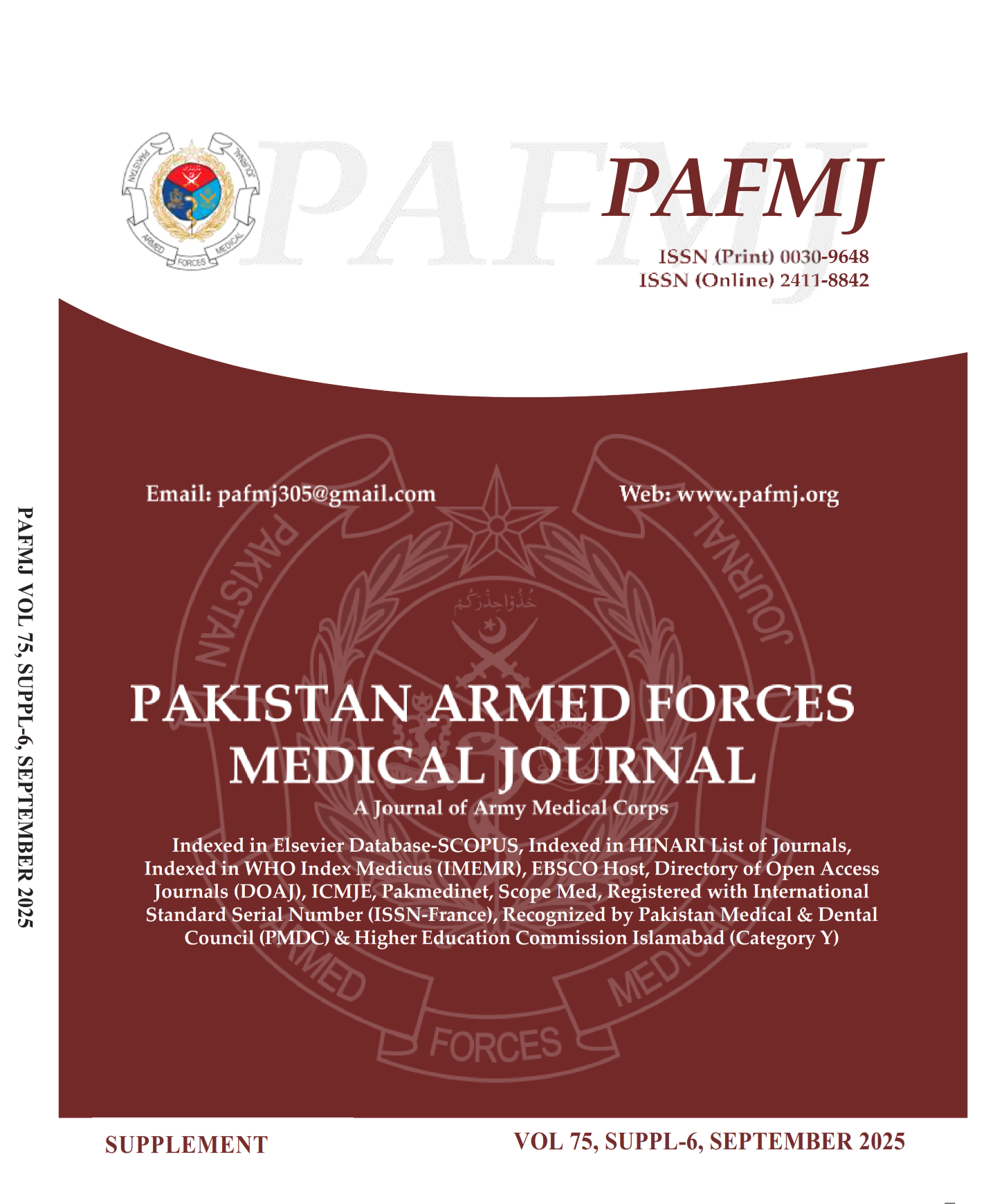Effectiveness of Platelets Rich Plasma Regimen in Diabetic Foot Ulcer Management
DOI:
https://doi.org/10.51253/pafmj.v75iSUPPL-6.8182Keywords:
Platelet-rich plasma, Conventional therapy, Diabetic foot ulcer Effectiveness of Platelets rich plasma regimen in diabetic foot ulcer managementAbstract
Objective: To determine effectiveness of autologous platelet-rich plasma gel versus conventional therapy regimen in the diabetic foot ulcers management based on the number of days required for granulation tissue growth and wound healing time.
Study Design: Cross sectional study.
Place and Duration of Study: Combined Military Hospital, Bannu Pakistan, from Aug 2021 to Jan 2022.
Methodology: In this study we enrolled 60 patients with diabetic foot ulcers and categorized them into two groups: those who got PRP (Group 1) and those who received conventional therapy regimen for wound (Group 2). The PRP group received gel based autologous PRP as a dressing, whereas the control group received no treatment. Consent was taken from every participant and study was conducted with the a.................
Results: Out of 60 patients with diabetic foot ulcer, 30 patients were given PRP therapy. Mean age with SD of patients were 57+9 years. In these 30 patients, 23(77%) were male and 7(23%) were female. Other 30 were managed with conventional regimen of therapy. Mean age with SD of these 30 patients were 58+11. In these 30 patients, 23(77%) were male and 7(23%) were female. Our study revealed that the healing rate of the PRP group was significantly higher than that of the conventional therapy regimen group. The PRP group experienced much faster healing rates each week (0.65) than the conventional therapy regimen group (0.50).........
Conclusion: Autologous platelet-rich plasma (PRP) is an effective and safe treatment for diabetic foot ulcers as compared to conventional treatment.
Downloads
References
1. Tran T, Le P, Pham P. Diabetic foot ulcer treatment by activated platelet rich plasma: a clinical study. Biomed Res Ther 2014; 1: 37–42.
2. Alvarsson A, Sandgren B, Wendel C, Alvarsson M, Brismar K. A retrospective analysis of amputation rates in diabetic patients: can lower extremity amputations be further prevented? Cardiovasc Diabetol 2012; 11:18.
3. Wu SC, Driver VR, Wrobel JS, Armstrong DG. Foot ulcers in the diabetic patient, prevention and treatment. Vasc Health Risk Manag 2007; 3(1): 65-76.
4. Lobo R, Kiernan TJ, Jaff MR. Medical therapy for critical limb ischemia and the diabetic foot: an update. J Cardiovasc Surg (Torino) 2013; 54(6): 671-678.
5. Steed DL, Attinger C, Colaizzi T, Crossland M, Franz M, Harkless L et al. Guidelines for the treatment of diabetic ulcers. Wound Repair Regen 2006; 14(6): 680-692.
6. Driver V, Hanft J, Fylling C, Beriou J, and the AutoloGelTM Diabetic Foot Ulcer Study Group. A prospective, randomized, controlled trial of autologous platelet-rich plasma gel for the treatment of diabetic foot ulcers. Ostomy Wound Manag 2006; 52: 68–87.
7. Yang L, Gao L, Yang LV, Wang J. Autologous platelet-rich gel for lower extremity ischemic ulcers in patients with type 2 diabetes. Int J Clin Exp Med 2017; 10: 13796–13801.
8. Moreno-Serrano A, García-Díaz JJ, Ferrer-Márquez M, Alarcón-Rodríguez R, Álvarez-García A, Reina-Duarte Á. Using autologous platelet-rich plasma for the treatment of complex fistulas. Rev Esp Enferm Dig 2016; 108(3): 123-128.
9. Frykberg RG, Driver VR, Carman D, Lucero B, Borris-Hale C, Fylling CP et al. Chronic wounds treated with a physiologically relevant concentration of platelet-rich plasma gel: a prospective case series. Ostomy Wound Manage 2010; 56(6): 36-44.
10. Villela DL, Santos VL. Evidence on the use of platelet-rich plasma for diabetic ulcer: a systematic review. Growth Factors 2010; 28(2): 111-116
11. Mishra A, Woodall J Jr, Vieira A. Treatment of tendon and muscle using platelet-rich plasma. Clin Sports Med 2009; 28(1): 113-125.
12. Pietramaggiori G, Scherer SS, Mathews JC, Gennaoui T, Lancerotto L, Ragno G et al. Quiescent platelets stimulate angiogenesis and diabetic wound repair. J Surg Res. 2010 May 1; 160(1): 169-177.
13. Pietramaggiori G, Scherer SS, Mathews JC, Alperovich M, Yang HJ, Neuwalder J et al. Healing modulation induced by freeze-dried platelet-rich plasma and micronized allogenic dermis in a diabetic wound model. Wound Repair Regen 2008; 16(2): 218-225.
14. Beer HD, Longaker MT, Werner S. Reduced expression of PDGF and PDGF receptors during impaired wound healing. J Invest Dermatol 1997; 109: 132–138.
15. Tang YQ, Yeaman MR, Selsted ME. Antimicrobial peptides from human platelets. Infect Immun 2002; 70: 6524e33.
16. Krijgsveld, J., S. A. J. Zaat, J. Meeldijk, P. A. van Veelen, G. Fang, B. Poolman et al. Thrombocidins, microbicidal proteins from human blood platelets, are C-terminal deletion products of CXC chemokines. J. Biol. Chem. 275: 20374–20381.
17. Jeong SH, Han SK, Kim WK. Treatment of diabetic foot ulcers using a blood bank platelet concentrate. Plast Reconstr Surg 2010; 125(3): 944-952
18. Elsaid A, El-Said M, Emile S, Youssef M, Khafagy W, Elshobaky A. Randomized Controlled Trial on Autologous Platelet-Rich Plasma Versus Saline Dressing in Treatment of Non-healing Diabetic Foot Ulcers. World J Surg 2020; 44(4): 1294-1301.
19. Singh SP, Kumar V, Pandey A, Pandey P, Gupta V, Verma R. Role of platelet-rich plasma in healing diabetic foot ulcers: a prospective study. J Wound Care 2018; 27(9): 550-556.
20. Suthar M, Gupta S, Bukhari S, Ponemone V. Treatment of chronic non-healing ulcers using autologous platelet rich plasma: a case series. J Biomed Sci 2017; 24(1): 16.
Downloads
Published
Issue
Section
License
Copyright (c) 2025 Muhammad Rehan Khan, Waqas Hanif, Afzal Saeed Awan, Usama Akhter, Syed Munim Hussain, Syed Mukarram Hussain

This work is licensed under a Creative Commons Attribution-NonCommercial 4.0 International License.















